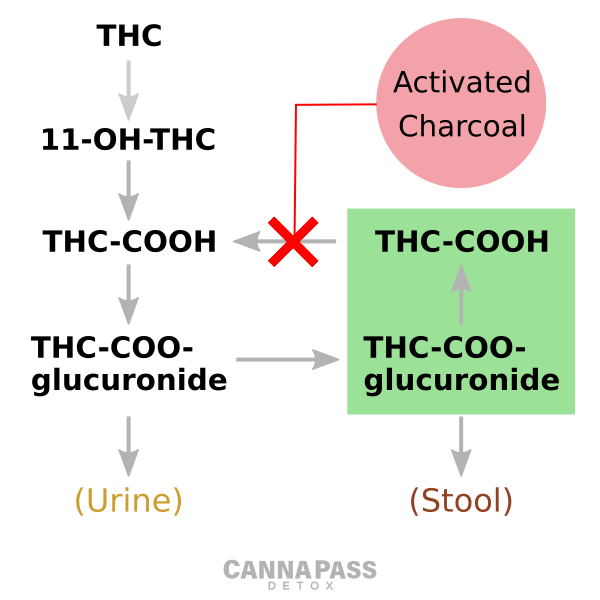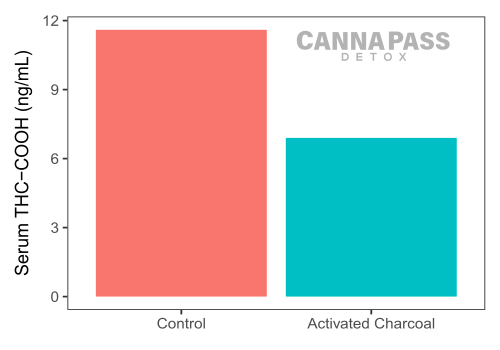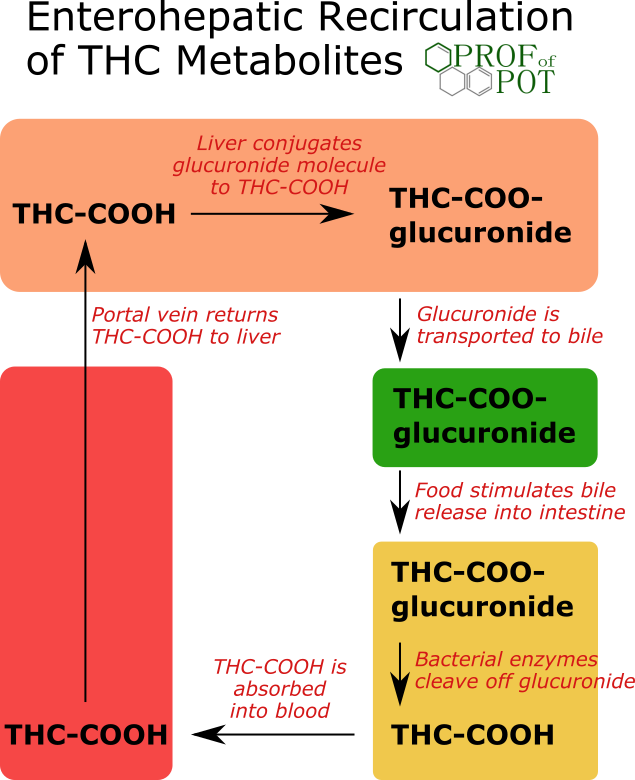Blocking Enterohepatic Recirculation With Activated Charcoal
QUICK SUMMARY
You may remember enterohepatic recirculation from our guide to THC Metabolism & Elimination. It sounds complicated, but it is not too hard to understand:
The “glucuronide” metabolite is pumped into your bile, which is then released into your intestines with each meal. This is your body’s attempt to remove this metabolite.
However, there are bacterial enzymes in your intestines which can convert the glucuronide metabolite back one step to THC-COOH. The THC-COOH metabolite is reabsorbed from your intestines, where it can be metabolized to the glucuronide again. This cycle can repeat itself, extending the time that these THC metabolites remain in your body.
There are various ways to block enterohepatic recirculation, but the method we recommend is activated charcoal. Activated charcoal is a porous substance that you can take by mouth, but that is not absorbed from your intestines.

Activated charcoal is proven to bind THC metabolites, including both the glucuronide and THC-COOH metabolites. This prevents reabsorption and the metabolites are then removed in your stool.
This detox method has been proven by a clinical study which showed that activated charcoal speeds the elimination of these metabolites. THC-COOH levels were reduced by almost half at 24 hours when activated charcoal was given several times over a 10 hour period.

FULL DETAILS (FROM A 2017 PROFOFPOT.COM BLOG POST)
Enterohepatic Recirculation of THC Metabolites
The fundamental misunderstanding about whether activated charcoal works comes down to one question. After THC has been completely absorbed, do its metabolites go into the GI tract where they can be absorbed by the activated charcoal? Most people think that’s not possible, but the answer is yes. The reason why: enterohepatic recirculation.

After you ingest cannabis, your body converts THC to the THC-COOH metabolite and then the THC-COO-glucuronide metabolite. The addition of the glucuronide is like a tag that targets the metabolite to be removed from your body. It is excreted into your urine and is the primary metabolite detected in drug tests.
It is also sent into the bile by your liver. Two studies (here and here) have tested the bile of cadavers for THC and metabolites. The THC-COO-glucuronide metabolite was found in incredibly high levels in the bile with a median concentration of 17 uM. Your body produces about 600 mL of bile every day, so this is the equivalent of about 3 mg of THC excreted into your GI tract on a daily basis.
[I know that 3 mg doesn’t sound like much, but keep in mind that the majority of THC is excreted through other metabolic pathways. 3 mg is significant relative to the amount of THC-COOH/glucuronide that is excreted into the urine.]
What happens to the metabolite once it is in your bile? Upon eating a meal, your body secretes bile into the GI tract. Since glucuronide metabolites are large and polar, they cannot be reabsorbed from the intestine. The idea is that it will be excreted in your feces. However, thanks to enzymes produced by the bacteria in your gut, most of the THC-COO-glucuronide is converted back to THC-COOH. The THC-COOH metabolite is then reabsorbed into the blood, where it can start the entire cycle over again.
This quantity of THC metabolites circulating through your bile and intestines represents a significant store that is completely separate from the commonly known fat storage. However, unlike the THC metabolites in fat that are basically inaccessible, we can use activated charcoal to interrupt this recirculation and clear the THC metabolites from our bodies. Once activated charcoal binds the metabolites, then they cannot be reabsorbed and you will poop them out.
Does Activated Charcoal Bind THC Metabolites?
One obvious prerequisite for activated charcoal to work is that it needs to bind THC metabolites. One study assessed this and showed that it does. 5 mg of activated charcoal was able to completely bind 1 mg of either the THC-COOH or THC-COO-glucuronide metabolites (and maybe even more, but they only tested up to 1 mg).
Dietary fiber (in the form of wheat bran) was also able to bind these metabolites. Although an appealing alternative to activated charcoal, a lot more was required – even 250 mg of wheat bran was not able to bind all of the THC metabolites. Fiber also did not bind the glucuronide metabolite as well as THC-COOH.
Clinical Evidence that Activated Charcoal Removes THC Metabolites
Based on the above information, we have a strong, although theoretical, reason to use activated charcoal. But it gets better…a full clinical study was conducted just to see the effects of activated charcoal on THC metabolites. It does not get any better than this!
Eight subjects were dosed intravenously with the THC-COOH metabolite on two occasions. They were randomly assigned to receive the first dose with or without activated charcoal and then crossed over to the other condition on the second dose.
They dosed 5 g of the activated charcoal at 6 different timepoints: 15 min before the THC-COOH dose and 5 min, 2, 4, 7 and 10 h after the dose (for a total of 30 g charcoal).

By 24 hours after the dose, the serum THC-COOH concentrations were 45% lower when subjects were treated with activated charcoal. I suspect that if activated charcoal was given continuously, rather than just for the first 10 hours, the effect would have been greater.

The amount of THC-COO-glucuronide excreted into the urine was reduced 21% with the activated charcoal treatment. THC-COO-glucuronide also reached undetectable levels in urine a full day earlier with activated charcoal.
Keep in mind that this study used just a single day of activated charcoal dosing, but collected urine for 4 days. I expect results would be even better if they had given activated charcoal for multiple days or if they had only collected urine for the first 24 hours when charcoal was given.
FAQ
I recommend using activated charcoal only in the 48 hours prior to when you want maximal detox. There are several reasons for this:
- The maximum metabolite-reducing effect is probably reached around then.
- The metabolite-reducing effect is only temporary. It does not significantly reduce THC or 11-OH-THC, so once you stop activated charcoal treatment, THC-COOH and glucuronide metabolites will be replenished from your stores of THC and 11-OH-THC.
- The recommended dose in the 2 Day Detox Protocol is pretty high. Although most people tolerate two days of this well, taking it for longer may lead to constipation.
There is really no evidence that it will. THC and 11-OH-THC can also be metabolized to glucuronides that undergo enterohepatic recirculation, but this is an extremely minor pathway.
Activated charcoal is the one we recommend, but there are other ways. These include:
- Fiber, which can also bind THC metabolites in the intestistines, but with much less efficiency. This is probably the mechanism behind the fruit pectin (Certo) method.
- Inhibiting beta-glucuronidase, which is the enzyme that converts the glucuronide metabolite back to THC-COOH.
- Antibiotics which kill the intestinal bacteria that produce the beta-glucuronidase enzyme

